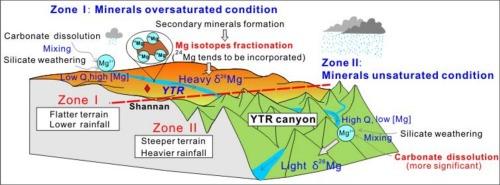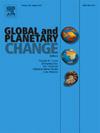青藏高原南部雅鲁藏布江流域河流镁同位素的地球化学行为
IF 4
1区 地球科学
Q1 GEOGRAPHY, PHYSICAL
引用次数: 0
摘要
河流中的镁(Mg)同位素组成一般由来源和分馏过程控制。然而,目前仍不清楚在流域尺度上这些因素在哪些情况下占主导地位。在本研究中,我们研究了青藏高原南部雅鲁藏布江流域的主要元素、微量元素以及镁和锶(Sr)同位素比值,以探讨镁同位素的地球化学行为和主要控制因素。研究表明,河流中的 Mg2+ 主要来自硅酸盐和碳酸盐的风化作用。河水中的δ26Mg首先受到不同岩性来源混合的影响,其检测范围为-1.63 ‰至-0.52 ‰。根据常见含镁次生矿物的饱和度指数,盆地被划分为两个区域。在山南市以上(Ⅰ区),河水大部分为过饱和矿物,δ26Mg 与 Ca/Mg 和 Sr/Mg 的比值呈正相关。这表明,在混合后,大多数水域可能会形成倾向于优先吸收 24Mg 的次生矿物(滑石和绿泥石),从而导致河水 δ26Mg 值增加。雷利模型和批次分馏模型的拟合系数为 0.9975 至 0.9997。山南市以下(Ⅱ区)河水多为非饱和矿物质,河水δ26Mg与87Sr/86Sr呈正相关,与Ca/Mg、Sr/Mg和HCO3/Na比值呈负相关。这表明河流δ26Mg受到碳酸盐溶解的影响,其动力学速率较快。我们对 YTR 流域河流 δ26Mg 值的分析可为解释全球河流系统中 δ26Mg 与 δ7Li 之间的关系提供参考。在矿物质过饱和的水体中,次生矿物质的形成导致同位素分馏,从而使这两个参数呈正相关;而在矿物质不饱和的水体中,δ26Mg 和 δ7Li值呈负相关,这可能是由于矿物质溶解占主导地位。本文章由计算机程序翻译,如有差异,请以英文原文为准。

Geochemical behavior of riverine magnesium isotopes in the Yarlung Tsangpo River Basin, southern Tibetan Plateau
The riverine magnesium (Mg) isotope composition is generally controlled by sources and fractionation processes. However, it remains unclear in which cases these factors are predominant at the basin scale. In this study, we investigated the major elements, trace elements, and Mg and strontium (Sr) isotope ratios in the Yarlung Tsangpo River (YTR) Basin, southern Tibetan Plateau (TP), to explore the geochemical behavior of Mg isotopes and the dominant controlling factors. Riverine Mg2+ was shown to derive primarily from the weathering of silicates and carbonates. Riverine δ26Mg, which is first influenced by the mixing of different lithological sources, was detected ranging from −1.63 ‰ to −0.52 ‰. According to the saturation indexes of common Mg-bearing secondary minerals, the basin was divided into two zones. Above Shannan City (Zone I), where river waters mostly were oversaturated with minerals, positive correlations were observed between δ26Mg and the Ca/Mg and Sr/Mg ratios. This indicated that, after mixing, secondary minerals (talc and chlorite), which tend to preferentially incorporate 24Mg, may be formed in most of waters, leading to an increase in riverine δ26Mg values. The Rayleigh and batch fractionation models were fitted with factors ranging from 0.9975 to 0.9997. Below Shannan City (Zone II), where river waters mostly were unsaturated with minerals, riverine δ26Mg was positively correlated with 87Sr/86Sr and negatively correlated with the Ca/Mg, Sr/Mg, and HCO3/Na ratios. This suggested that the riverine δ26Mg were influenced by carbonate dissolution with faster kinetic rates. Our analysis of riverine δ26Mg values in the YTR Basin may be a reference for interpreting the relationships between δ26Mg and δ7Li in river systems worldwide. In minerals-oversaturated waters, secondary mineral formation was shown to lead to isotope fractionation, resulting in a positive correlation between the two parameters, whereas in minerals-unsaturated waters, the δ26Mg and δ7Li values were negatively correlated, possibly due to the predominance of mineral dissolution.
求助全文
通过发布文献求助,成功后即可免费获取论文全文。
去求助
来源期刊

Global and Planetary Change
地学天文-地球科学综合
CiteScore
7.40
自引率
10.30%
发文量
226
审稿时长
63 days
期刊介绍:
The objective of the journal Global and Planetary Change is to provide a multi-disciplinary overview of the processes taking place in the Earth System and involved in planetary change over time. The journal focuses on records of the past and current state of the earth system, and future scenarios , and their link to global environmental change. Regional or process-oriented studies are welcome if they discuss global implications. Topics include, but are not limited to, changes in the dynamics and composition of the atmosphere, oceans and cryosphere, as well as climate change, sea level variation, observations/modelling of Earth processes from deep to (near-)surface and their coupling, global ecology, biogeography and the resilience/thresholds in ecosystems.
Key criteria for the consideration of manuscripts are (a) the relevance for the global scientific community and/or (b) the wider implications for global scale problems, preferably combined with (c) having a significance beyond a single discipline. A clear focus on key processes associated with planetary scale change is strongly encouraged.
Manuscripts can be submitted as either research contributions or as a review article. Every effort should be made towards the presentation of research outcomes in an understandable way for a broad readership.
 求助内容:
求助内容: 应助结果提醒方式:
应助结果提醒方式:


